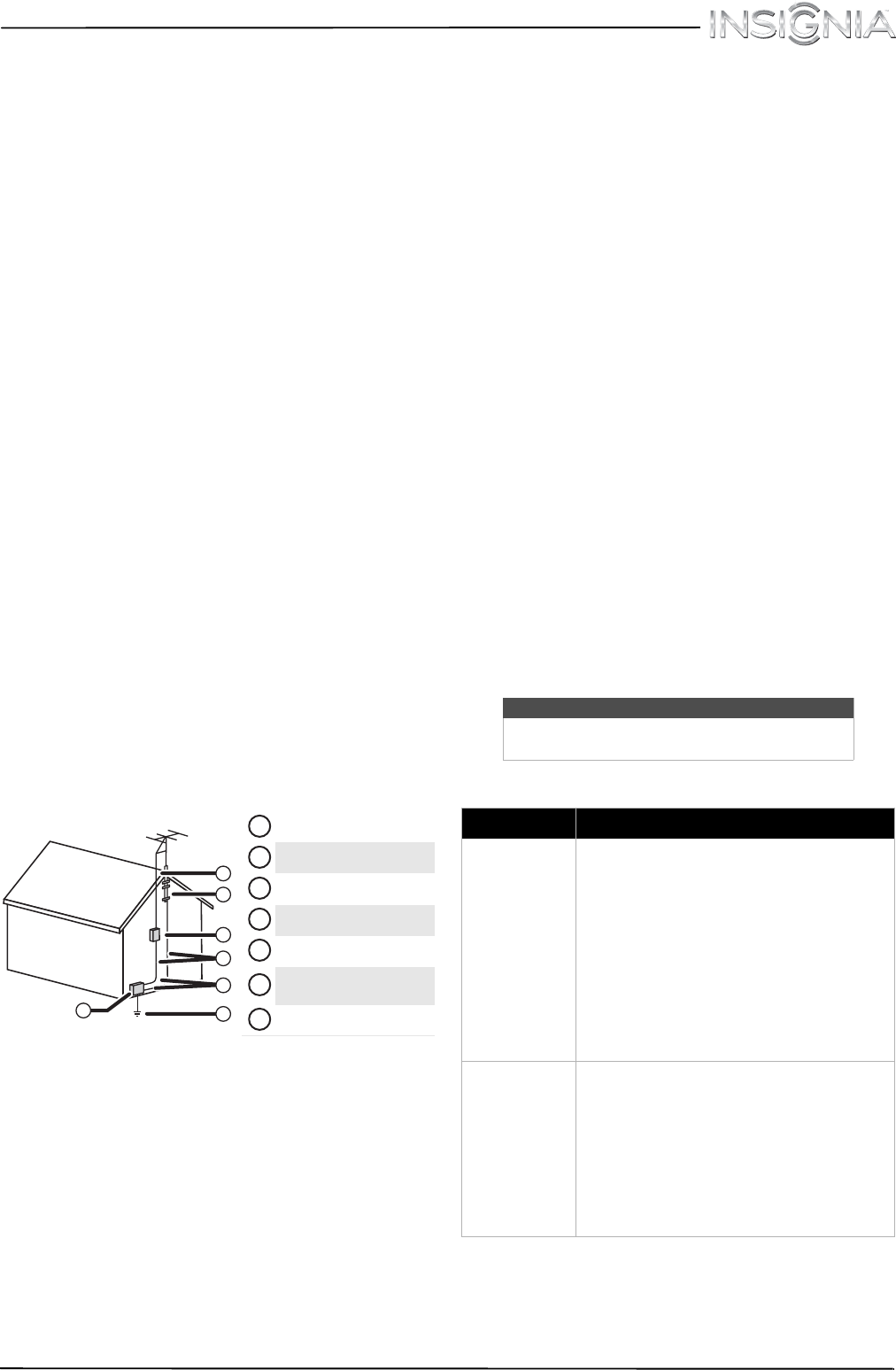
4
www.insigniaproducts.com
Servicing
These servicing instructions are for use by qualified service
personnel only. To reduce the risk of electric shock, do not
perform any servicing other than that contained in the
operating instructions unless you are qualified to do so.
CAUTION
Damage requiring service
Unplug this TV from the power outlet and refer servicing
to qualified service personnel under the following
conditions:
• When the power supply cord or plug is damaged or
frayed.
• If liquid has been spilled or objects have fallen into
your TV.
• If your TV has been exposed to rain or water.
• If your TV does not operate normally by following the
operating instructions. Adjust only those controls
that are covered by the operating instructions
because incorrect adjustment of other controls may
result in damage and will often require extensive
work by a qualified technician to restore your TV to its
normal operation.
• If your TV has been dropped or damaged in any way.
• When your TV exhibits a distinct change in
performance.
Outdoor antenna grounding
If an outside antenna or cable system is connected to your
TV, make sure that the antenna or cable system is
grounded to provide some protection against voltage
surges and built-up static charges. Article 810 of the
National Electrical Code, ANSI/NFPA No. 70, provides
information with respect to correct grounding of the mast
and supporting structure, grounding of the lead-in wire to
an antenna discharge unit, size of grounding conductors,
location of the antenna-discharge unit, connection to
grounding electrodes, and requirements for the grounding
electrode.
Note to CATV system installer
Article 820 of the National Electrical Code, ANSI/NFPA No.
40 provides guidance for correct grounding. Specifically, it
states that the cable ground must be connected to the
grounding system of the building as close to the point of
cable entry as practical.
Condensation
Moisture will form on the TV if the TV is brought from cool
surroundings into a warm room or if the temperature of
the room rises suddenly. When this happens, the TV's
performance may be impaired. To prevent this, let the TV
stand in its new surroundings for about an hour before
switching it on, or make sure that the room temperature
rises gradually.
Condensation may also form during the summer if the TV
is exposed to the breeze from an air conditioner. In such
cases, change the location of the TV.
Mobile telephone warning
To avoid interference with your TV picture and sound,
operating problems, or even damage, keep your cordless
and cellular telephones away from the TV.
End of life directives
Your TV may contain materials that are regulated for
environmental reasons. Your TV also contains materials
that can be recycled and reused. To help protect the
environment, contact your local authorities for information
about disposal or recycling and about finding a recycler in
your area before you dispose of your TV.
Non-active pixels
The LCD panel contains almost 3 million thin film
transistors, which provide exceptionally sharp video
quality. Occasionally, a few non-active pixels may appear
on the screen as a fixed blue, green, or red point. These
non-active pixels do not adversely affect the performance
of your TV, and are not considered defects.
Troubleshooting
Remote control
Antenna lead-in wire
Grounding clamp
Antenna discharge unit
Grounding conductors
Ground clamps
Power service grounding
electrode system
Electric service equipment
2
1
3
4
5
6
7
1
2
3
4
5
6
7
Warning
Do not try to repair your TV yourself. Contact
authorized service personnel.
Problem Solution
Remote control does
not work
• Make sure that the power cord is correctly connected to
a power outlet.
• Make sure that there are no obstructions between the
remote control and the remote control sensor on the
front of the TV.
• Point the remote control directly at the remote control
sensor on your TV. For the location of the remote
control sensor, see “Front view” in your Quick Setup
Guide.
• Make sure that the batteries are installed correctly. See
“When can I turn on my TV” in your Quick Setup Guide.
• Replace dead batteries with new batteries. See “When
can I turn on my TV” in your Quick Setup Guide.
Trouble programming
your existing
universal remote
control
• See instructions and a table of common codes in
“Programming a different universal remote control” in
the online User Guide.
• Codes are subject to change. For up-to-date codes, go
to www.insigniaproducts.com/remotecodes.
• Replace dead batteries with new batteries. See “When
can I turn on my TV” in your Quick Setup Guide.
• Refer to the User Guide that accompanied your
universal remote control and contact the manufacturer
if problems persist.










